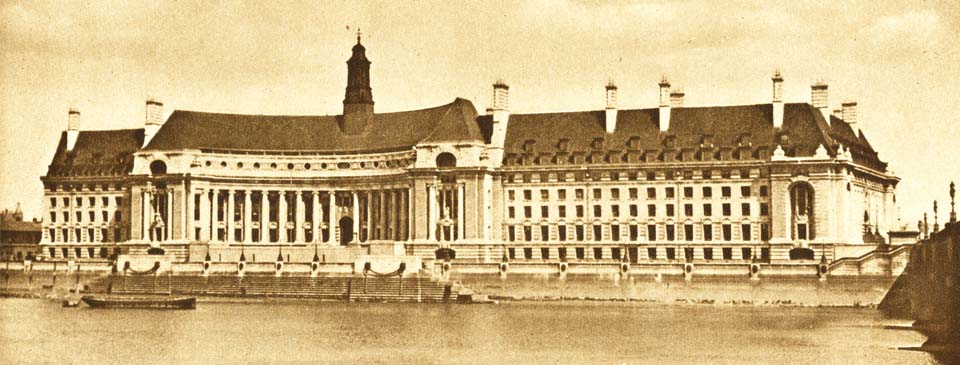In brief – Early-20th century London

County Hall, offices of the London County Council, opened in 1922 on the south side of Westminster Bridge. At that time it was unfinished, hence its lack of symmetry in this photograph. It was built on the site of the earlier Metropolitan Board of Works offices and various wharves and factories. It served as the headquarters of local London government until 1986.
Despite competition from cinemas, the period until the Second World War was a golden age for theatres. Numerous new venues opened in the West End – notably along Shaftesbury Avenue – and suburban centres, presenting a mixture of comedy, drama, musicals and variety.
The most popular spectator sports in London during the 1920s and 30s were greyhound racing and speedway. Football league games were popular with working-class men but less so than in the north of England. FA Cup Finals were originally held at Crystal Palace until the opening of Wembley Stadium in 1923 and attendances of up to 120,000 standing on terraces were recorded. Other sports such as boxing, wrestling, cricket, horse-racing and ice-skating were also enjoyed by Londoners.
The 1908 Olympic Games were due to be held in Rome but were instead diverted to London following the eruption of Mount Vesuvius two years earlier. The main venue was the White City stadium, where the games ran alongside the Franco-British Exhibition. It was at those games that the length of the modern marathon was fixed as the distance between Windsor Castle and Buckingham Palace in order to accommodate the royal family. The 1944 games were due to be held in London but delayed until four years later due to the Second World War. The main venue was Wembley Stadium, with swimming held at the adjacent Empire Pool. Other venues included the stadiums of Fulham, Tottenham and Arsenal football clubs and Harringay Arena.
With the growth in railways and passengers liners, London increasingly became a tourist destination for the wealthy and those visiting events such as the Franco-British and British Empire exhibitions. Large new hotels were established, such as the Russell, Imperial, Waldorf, Ritz, Grosvenor and Dorchester. Fine restaurants such as the Criterion, Café Royal, Romano’s, Quaglino’s, Simpson’s in the Strand, and Kettner’s opened. For everyday dining the J. Lyon’s Company established their Corner Houses, and cafés were opened by Italians and Cypriots.
London’s first aerodrome was opened at Hendon in 1911 and regular scheduled flights to the Continent started in 1919 from Hounslow Heath. Just a year later international civilian flights began from Croydon, which was slightly nearer the Continent and on a main road. It became London’s main airport until after the Second World War. Scheduled flights were soon operating to Paris, Amsterdam, Rotterdam and Berlin, making it the world’s first major civilian airport.
There had long been resentment of the large numbers of immigrants in London, particularly the Jews of the East End. At the beginning of the century the British Brothers League campaigned under the slogan ‘England for the English’. Events in other European countries and unemployment around Britain had political effects in London. During the 1930s there was a rise in the Communist movement in Britain while the Fascist government in Italy and Nazis in Germany were the backdrop to the rise of the British Union of Fascists led by Sir Oswald Mosley. The BUF gained a reputation for their strong anti-Semitic views and thuggery during the mid-decade, attacking Jews, organizing marches, and daubing swastikas and anti-Semitic slogans around the East End.


